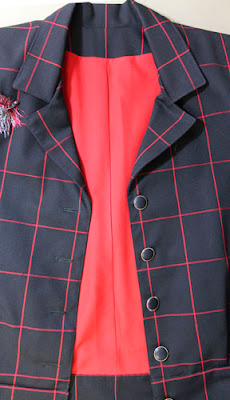www.surefitdesigns.com
The more you sew, the more your confidence grows.
(Adapted from Industry Guide to Sewing Order by Connie Crawford)
(PS - Sometimes I really detest Blogger...I simply couldn't get the text and the images lined up where I wanted them to display...But I'm sure you'll get the picture. LOL)
Happy Sewing!
Glenda The Good Stitch
When you’ve sewn for ages your mind kicks into gear when
constructing a garment. What do you do
first? What do you sew next? You kind of know the order in which things
should be done. But for the novice, it
might not be so obvious. Use these guidelines and you’ll generally be well on
your way to a comfortable level of knowing how to sew something together.
First, do as much work on a major pattern piece as possible
before joining them to another major piece.
All darts, pleats, tucks and style lines (like princess lines) would be
sewn first. Sew side seams and shoulder
seams only when you can’t do anything more on the major piece. This makes pressing easier, simplifies the
sewing process, makes the garment easier to handle in the machine and the
entire construction process will take less time.
Read through these steps first, then analyze them in
relation to the garment you want to sew.
Eliminate those that don’t apply, but stay with the general flow of
steps.
- Attach any interfacing. Whether for a blouse, dress, coat, shirt or waistband of pants or shirt, do this first.
- Darts, tucks, pleats. Do these next.
- Sew style lines. Does your pattern have style lines like princess lines or yokes? Anything that is not a shoulder or side seam should be sewn now.
- Pockets. Apply them to the major piece taking care that they are balanced from one side to the other.
- Insert the zipper. If possible insert the zipper while the major piece is still flat, but if it is a dress with a waist seam and the zipper extends into the skirt, it will be applied later.
- Shoulder seams generally come next.
- Sew a 'shirt-style' sleeve. The lower, flatter sleeve cap lends itself to sewing into the front and back armscye at this time.
- For shirts, sew side seams from hem up through underarm to sleeve hem edge. For pants, sew inseams and side seams. For a dress, if the design has an attached skirt, sew the skirt and bodice side seams separately, but don't attach skirt the skirt to the bodice yet.
- For pants, sew crotch seams.
- Sew waistband or facings for pants/skirts. Finish elastic waists at this time.
- Sew collar. Prepare collar. Make sure facings have been prepped. Attach collar.
- Prepare sleeve. Prepare any detailing like plackets, gathers, etc. before stitching the underarm seam. Apply cuffs if applicable.
- Set in sleeve.
- Neckline/armhole facings. Sew the neckline or armhole facings if there is no collar.
- Dress waist seam. For 2-piece dresses, sew bodice to skirt at waistline.
- Apply zipper. For dresses with waistline seams, add the zipper now.
- Finish hem.
- Closures. Buttons, buttonholes, hooks and eyes, frog closures, snaps should be sewn at this time.
- Belts, bows or additional trimmings may happen now.
- Always Press As You Sew!

(Adapted from Industry Guide to Sewing Order by Connie Crawford)
(PS - Sometimes I really detest Blogger...I simply couldn't get the text and the images lined up where I wanted them to display...But I'm sure you'll get the picture. LOL)
Happy Sewing!
Glenda The Good Stitch



















